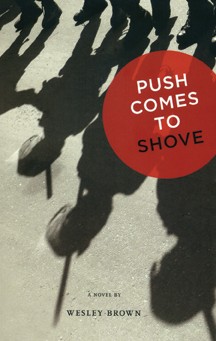No, the price listed above is not a typesetting error. The back cover of Push Comes to Shove reads: THIS BOOK IS FREE.
You may remember Abbie Hoffman’s 1971 call to revolution against government/corporate oppression, Steal This Book (now available on Kindle for the low, low price of $10.88). But Concord Free Press is after a different kind of revolution: a generosity-based publishing model. In exchange for your copy of the book, the company asks you to “give away money to a local charity, someone who needs it, or a stranger on the street,” then log onto its website (www.concordfreepress.com) and enter your donation amount. Donations presently total more than $47,000—and this is only the publisher’s second book.
The novel is the third from acclaimed African-American novelist and playwright Wesley Brown, who teaches at Bard College at Simon’s Rock. He worked with the Mississippi Freedom Democratic Party in 1965 and joined the Black Panther Party in 1968. He also served a three-year sentence in Lewisburg Federal Penitentiary for refusing induction into the armed services during the Vietnam War.
His life experience puts the author on solid terrain in the novel, which opens as New Year’s Eve 1969 approaches. Police raid the headquarters of the black activist group Push Comes to Shove. Muriel Pointer, a hotheaded, seemingly fearless member of the group, survives what is less a raid than an all-out attack. Her lover and fellow activist, Walter Armstead, dies instantly at the hands of a shotgun-wielding cop.
Traumatized, arrested, questioned, and released, Muriel enters the labyrinthine world of shadowy figures who execute a series of violent reprisals for Walter’s death and the elusive cop who tries repeatedly to catch them. Or is the man with the badge just another assassin?
The story is told mostly from two points of view, each first person, with occasional interruptions from a third-person narrator. Brown does an admirable job of bringing out subtle differences in tone and language as he shifts between characters: Muriel’s voice captures the emotional numbness that often sets in following trauma; Raymond takes the more reliable narrative role, though he brings his own overstuffed satchel full of issues when he enters Muriel’s reality.
Push Comes to Shove spans more than a decade, and though not a historical novel in the traditional sense, it opens a door to the world of the black liberation movement at a critical moment in American history. Muriel turns to journalism as an outlet for her rage at injustice, revealing the stories behind the extremists’ activist violence against the New York Police Department. Raymond, the steadfast professor of history who understands the value of putting distance between oneself and events in order to more fully understand them, tries to pull Muriel away from her dangerous undertakings and into family life.
Though the ’70s may be seen by many as lacking the outré panache of the ’60s, it was perhaps a necessary step back from the intensity and hysteria of the previous era in an attempt to understand—What the hell just happened? Are we okay?
One of the major conflicts between Muriel and Raymond involves her attitude toward risk. Her opening line is “Like the rebellious of every generation, I was horny with idealism and foolishly believed that throwing my body in the path of injustice was enough to stop it.”
It may be significant that Push Comes to Shove ends in 1984. A nod to Orwell? Almost certainly. And more to the point: Thanks to Orwell’s novel, 1984 has become synonymous with the phrase Big Brother Is Watching.

















